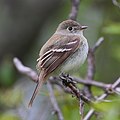| Eastern wood pewee | |
|---|---|
 | |
| In Central Park, New York, USA | |
| Song recorded in Ontario, Canada | |
| Scientific classification | |
| Kingdom: | Animalia |
| Phylum: | Chordata |
| Class: | Aves |
| Order: | Passeriformes |
| Family: | Tyrannidae |
| Genus: | Contopus |
| Species: | C. virens |
| Binomial name | |
| Contopus virens (Linnaeus, 1766) | |
 | |
| Approximate distribution map Breeding Migration Non-breeding | |
| Synonyms | |
Muscicapa virensLinnaeus, 1766 | |
The eastern wood pewee (Contopus virens) is a small tyrant flycatcher from North, Central and South America. This bird and the western wood pewee (C. sordidulus) were formerly considered a single species. The two species are virtually identical in appearance, and can be distinguished most easily by their calls.





